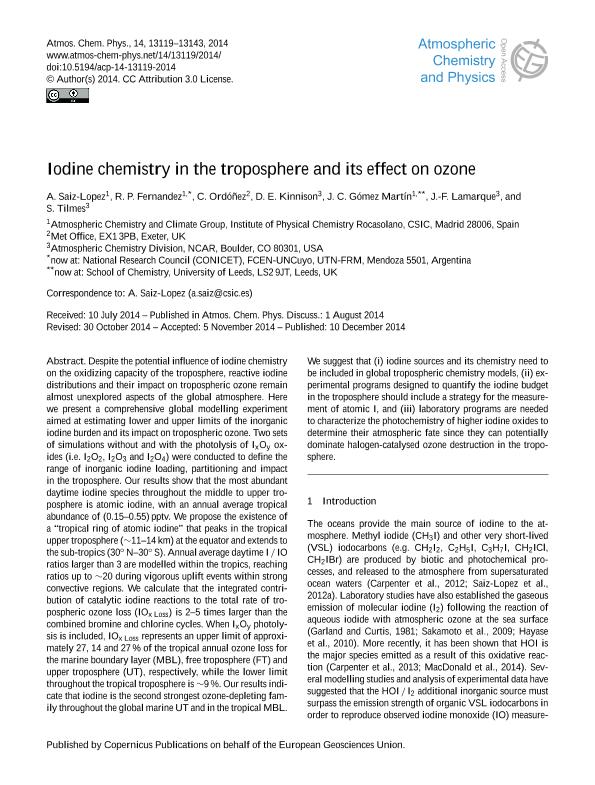Mostrar el registro sencillo del ítem
dc.contributor.author
Saiz-lopez, Alfonso

dc.contributor.author
Fernandez, Rafael Pedro

dc.contributor.author
Ordóñez, C.
dc.contributor.author
Kinnison, D.E.
dc.contributor.author
Gómez, Martin J. C.
dc.contributor.author
Lamarque, J. F.
dc.contributor.author
Tilmes, Simone

dc.date.available
2020-03-19T18:46:55Z
dc.date.issued
2014-12
dc.identifier.citation
Saiz-lopez, Alfonso; Fernandez, Rafael Pedro; Ordóñez, C.; Kinnison, D.E.; Gómez, Martin J. C.; et al.; Iodine chemistry in the troposphere and its effect on ozone; Copernicus Publications; Atmospheric Chemistry and Physics; 14; 23; 12-2014; 13119-13143
dc.identifier.issn
1680-7316
dc.identifier.uri
http://hdl.handle.net/11336/100317
dc.description.abstract
Despite the potential influence of iodine chemistry on the oxidizing capacity of the troposphere, reactive iodine distributions and their impact on tropospheric ozone remain almost unexplored aspects of the global atmosphere. Here we present a comprehensive global modelling experiment aimed at estimating lower and upper limits of the inorganic iodine burden and its impact on tropospheric ozone. Two sets of simulations without and with the photolysis of IxOy oxides (i.e. I2O2, I2O3 and I2O4) were conducted to define the range of inorganic iodine loading, partitioning and impact in the troposphere. Our results show that the most abundant daytime iodine species throughout the middle to upper troposphere is atomic iodine, with an annual average tropical abundance of (0.15-0.55) pptv. We propose the existence of a "tropical ring of atomic iodine" that peaks in the tropical upper troposphere (∼11-14 km) at the equator and extends to the sub-tropics (30°N-30°S). Annual average daytime I = IO ratios larger than 3 are modelled within the tropics, reaching ratios up to ∼20 during vigorous uplift events within strong convective regions. We calculate that the integrated contribution of catalytic iodine reactions to the total rate of tropospheric ozone loss (IOx Loss) is 2-5 times larger than the combined bromine and chlorine cycles. When IxOy photolysis is included, IOx Loss represents an upper limit of approximately 27, 14 and 27% of the tropical annual ozone loss for the marine boundary layer (MBL), free troposphere (FT) and upper troposphere (UT), respectively, while the lower limit throughout the tropical troposphere is ∼9 %. Our results indicate that iodine is the second strongest ozone-depleting family throughout the global marine UT and in the tropical MBL. We suggest that (i) iodine sources and its chemistry need to be included in global tropospheric chemistry models, (ii) experimental programs designed to quantify the iodine budget in the troposphere should include a strategy for the measurement of atomic I, and (iii) laboratory programs are needed to characterize the photochemistry of higher iodine oxides to determine their atmospheric fate since they can potentially dominate halogen-catalysed ozone destruction in the troposphere.
dc.format
application/pdf
dc.language.iso
eng
dc.publisher
Copernicus Publications

dc.rights
info:eu-repo/semantics/openAccess
dc.rights.uri
https://creativecommons.org/licenses/by/2.5/ar/
dc.subject
Iodine Chemistry
dc.subject
Very-Short Lived
dc.subject
tropical rings of atomic halogens
dc.subject
tropospheric ozone
dc.subject.classification
Meteorología y Ciencias Atmosféricas

dc.subject.classification
Ciencias de la Tierra y relacionadas con el Medio Ambiente

dc.subject.classification
CIENCIAS NATURALES Y EXACTAS

dc.title
Iodine chemistry in the troposphere and its effect on ozone
dc.type
info:eu-repo/semantics/article
dc.type
info:ar-repo/semantics/artículo
dc.type
info:eu-repo/semantics/publishedVersion
dc.date.updated
2020-03-18T20:36:11Z
dc.identifier.eissn
1680-7324
dc.journal.volume
14
dc.journal.number
23
dc.journal.pagination
13119-13143
dc.journal.pais
Alemania

dc.description.fil
Fil: Saiz-lopez, Alfonso. Consejo Superior de Investigaciones Científicas. Instituto de Química Física; España. Consejo Nacional de Investigaciones Científicas y Técnicas. Centro Científico Tecnológico Conicet - Mendoza; Argentina
dc.description.fil
Fil: Fernandez, Rafael Pedro. Consejo Nacional de Investigaciones Científicas y Técnicas. Centro Científico Tecnológico Conicet - Mendoza; Argentina. Consejo Superior de Investigaciones Científicas. Instituto de Química Física; España
dc.description.fil
Fil: Ordóñez, C.. Met Office; Reino Unido
dc.description.fil
Fil: Kinnison, D.E.. National Center For Atmospheric Research. Amospheric Chemistry División; Estados Unidos
dc.description.fil
Fil: Gómez, Martin J. C.. Consejo Superior de Investigaciones Científicas. Instituto de Química Física; España
dc.description.fil
Fil: Lamarque, J. F.. National Center For Atmospheric Research. Amospheric Chemistry División; Estados Unidos
dc.description.fil
Fil: Tilmes, Simone. National Center For Atmospheric Research. Amospheric Chemistry División; Estados Unidos
dc.journal.title
Atmospheric Chemistry and Physics

dc.relation.alternativeid
info:eu-repo/semantics/altIdentifier/url/http://www.atmos-chem-phys.net/14/13119/2014/acp-14-13119-2014.html
dc.relation.alternativeid
info:eu-repo/semantics/altIdentifier/doi/http://dx.doi.org/10.5194/acp-14-13119-2014
Archivos asociados
